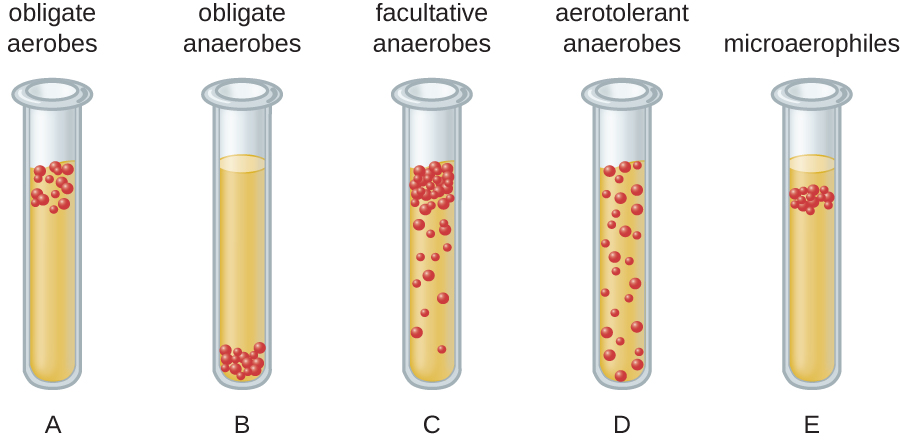| << Chapter < Page | Chapter >> Page > |
The growth of bacteria with varying oxygen requirements in thioglycolate tubes is illustrated in [link] . In tube A, all the growth is seen at the top of the tube. The bacteria are obligate (strict) aerobe s that cannot grow without an abundant supply of oxygen. Tube B looks like the opposite of tube A. Bacteria grow at the bottom of tube B. Those are obligate anaerobe s, which are killed by oxygen. Tube C shows heavy growth at the top of the tube and growth throughout the tube, a typical result with facultative anaerobe s. Facultative anaerobes are organisms that thrive in the presence of oxygen but also grow in its absence by relying on fermentation or anaerobic respiration, if there is a suitable electron acceptor other than oxygen and the organism is able to perform anaerobic respiration. The aerotolerant anaerobe s in tube D are indifferent to the presence of oxygen. They do not use oxygen because they usually have a fermentative metabolism, but they are not harmed by the presence of oxygen as obligate anaerobes are. Tube E on the right shows a “Goldilocks” culture. The oxygen level has to be just right for growth, not too much and not too little. These microaerophile s are bacteria that require a minimum level of oxygen for growth, about 1%–10%, well below the 21% found in the atmosphere.
Examples of obligate aerobes are Mycobacterium tuberculosis , the causative agent of tuberculosis and Micrococcus luteus , a gram-positive bacterium that colonizes the skin. Neisseria meningitidis , the causative agent of severe bacterial meningitis , and N. gonorrheae , the causative agent of sexually transmitted gonorrhea , are also obligate aerobes.

Many obligate anaerobes are found in the environment where anaerobic conditions exist, such as in deep sediments of soil, still waters, and at the bottom of the deep ocean where there is no photosynthetic life. Anaerobic conditions also exist naturally in the intestinal tract of animals. Obligate anaerobes, mainly Bacteroidetes , represent a large fraction of the microbes in the human gut. Transient anaerobic conditions exist when tissues are not supplied with blood circulation; they die and become an ideal breeding ground for obligate anaerobes. Another type of obligate anaerobe encountered in the human body is the gram-positive, rod-shaped Clostridium spp. Their ability to form endospores allows them to survive in the presence of oxygen. One of the major causes of health-acquired infections is C. difficile , known as C. diff. Prolonged use of antibiotics for other infections increases the probability of a patient developing a secondary C. difficile infection. Antibiotic treatment disrupts the balance of microorganisms in the intestine and allows the colonization of the gut by C. difficile , causing a significant inflammation of the colon.
Other clostridia responsible for serious infections include C. tetani , the agent of tetanus, and C. perfringens , which causes gas gangrene . In both cases, the infection starts in necrotic tissue (dead tissue that is not supplied with oxygen by blood circulation). This is the reason that deep puncture wounds are associated with tetanus. When tissue death is accompanied by lack of circulation, gangrene is always a danger.

Notification Switch
Would you like to follow the 'Microbiology' conversation and receive update notifications?